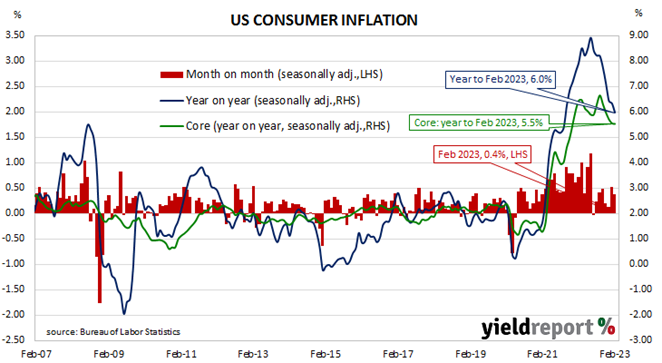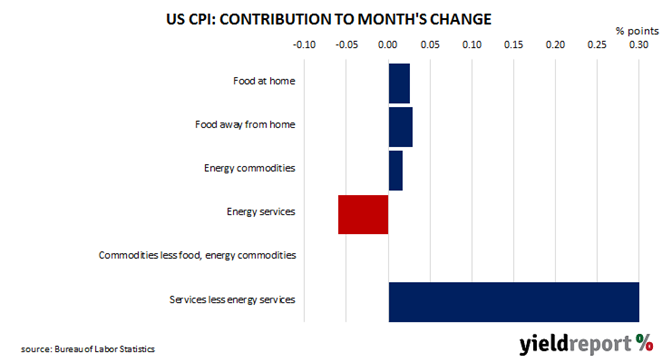Summary: US CPI up 0.4% in February, in line with expectations; “core” rate up 0.5%; ANZ: US Fed “still has work to do”; Treasury yields rise; rate-rise expectations firm; NAB: figures “stubbornly high”, “not telling optimistic stories of disinflation”; non-energy services prices main driver, adds 0.35 ppts.
The annual rate of US inflation as measured by changes in the consumer price index (CPI) halved from nearly 3% in the period from July 2018 to February 2019. It then fluctuated in a range from 1.5% to 2.0% through 2019 before rising above 2.0% in the final months of that year. Substantially lower rates were reported from March 2020 to May 2020 and they remained below 2% until March 2021. Rates have since risen significantly.
The latest US CPI figures released by the Bureau of Labor Statistics indicated seasonally-adjusted consumer prices increased by 0.4% on average in February. The result was in line with expectations but slightly lower than January’s 0.5% increase. On a 12-month basis, the inflation rate slowed from 6.3% to 6.0%.
“Headline” inflation is known to be volatile and so references are often made to “core” inflation for analytical purposes. The core prices index, the index which excludes the more variable food and energy components, increased by 0.5% on a seasonally-adjusted basis for the month. The rise was above the 0.4% increase which had been generally expected as well as January’s 0.4% increase but the annual growth rate still remained steady at 5.5%.
“These figures were largely as expected but confirm the Fed still has work to do to get inflation under control,” said ANZ economist Kishti Sen.
US Treasury bond yields jumped on the day, especially at the short end, buoyed by news of a depositor bailout for Silicon Valley Bank. By the close of business, the 2-year Treasury yield had added 27bps to 4.25%, the 10-year yield had gained 11bps to 3.69% while the 30-year yield finished 10bps higher at 3.81%.
In terms of US Fed policy, expectations of higher federal funds rates over the next 12 months firmed considerably, partially reversing some of the previous day’s movements. At the close of business, contracts implied the effective federal funds rate would average 4.6375% in March, 6bps higher than the current spot rate, and then climb to an average of 4.755% in April. May futures contracts implied a 4.88% average effective federal funds rate while March 2024 contracts implied 4.03%.
NAB economist Taylor Nugent summarised the figures as “stubbornly high” and “not telling optimistic stories of disinflation.” He noted figures over the most recent three month period was just slightly below those of the most recent six-month period and described this as “hardly a compelling downtrend so far.” The largest influence on headline results is often the change in fuel prices. Prices of “Energy commodities”, the segment which contains vehicle fuels, increased by 0.5% and contributed just 0.02 percentage points to the total. However, prices of non-energy services, the segment which includes actual and implied rents, again had the largest effect on the total, adding 0.35 percentage points after increasing by 0.6% on average.



